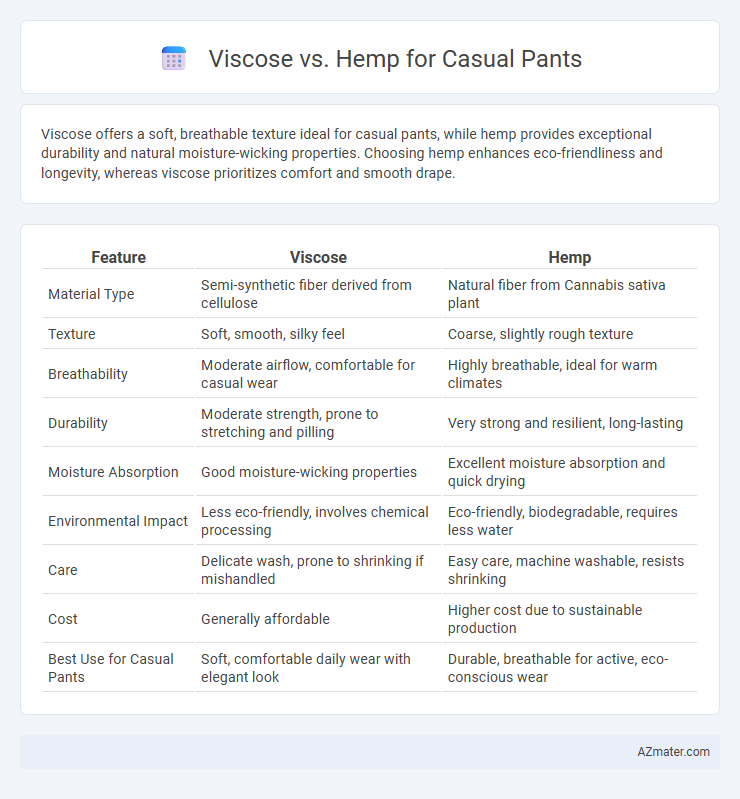Viscose offers a soft, breathable texture ideal for casual pants, while hemp provides exceptional durability and natural moisture-wicking properties. Choosing hemp enhances eco-friendliness and longevity, whereas viscose prioritizes comfort and smooth drape.
Table of Comparison
| Feature | Viscose | Hemp |
|---|---|---|
| Material Type | Semi-synthetic fiber derived from cellulose | Natural fiber from Cannabis sativa plant |
| Texture | Soft, smooth, silky feel | Coarse, slightly rough texture |
| Breathability | Moderate airflow, comfortable for casual wear | Highly breathable, ideal for warm climates |
| Durability | Moderate strength, prone to stretching and pilling | Very strong and resilient, long-lasting |
| Moisture Absorption | Good moisture-wicking properties | Excellent moisture absorption and quick drying |
| Environmental Impact | Less eco-friendly, involves chemical processing | Eco-friendly, biodegradable, requires less water |
| Care | Delicate wash, prone to shrinking if mishandled | Easy care, machine washable, resists shrinking |
| Cost | Generally affordable | Higher cost due to sustainable production |
| Best Use for Casual Pants | Soft, comfortable daily wear with elegant look | Durable, breathable for active, eco-conscious wear |
Introduction to Viscose and Hemp Fabrics
Viscose is a semi-synthetic fiber made from regenerated cellulose, known for its silky texture, breathability, and smooth drape, making it a popular choice for casual pants that require softness and comfort. Hemp fabric, derived from the Cannabis sativa plant, offers exceptional durability, natural antimicrobial properties, and eco-friendly benefits due to its low environmental impact and biodegradability. When comparing viscose and hemp for casual pants, considerations include viscose's moisture-wicking ability and vibrant dye retention against hemp's rugged strength and resistance to wear.
Understanding Viscose: Properties and Production
Viscose, a semi-synthetic fiber derived from cellulose, is known for its smooth texture, breathability, and excellent drape, making it a popular choice for casual pants. The production process involves chemically treating wood pulp or cotton waste with sodium hydroxide and carbon disulfide to create a viscous solution, which is then spun into fibers. This manufacturing method results in a fabric that combines the comfort of natural fibers with versatility in clothing applications.
Exploring Hemp: Characteristics and Manufacturing
Hemp fabric is highly durable, breathable, and naturally antimicrobial, making it an excellent choice for casual pants that require both comfort and longevity. The manufacturing process of hemp involves minimal chemical treatment, enhancing its eco-friendliness compared to viscose, which relies heavily on chemical-intensive production from wood pulp. Hemp fibers also have moisture-wicking properties and improve with age, providing a sustainable and practical alternative to viscose in casual wear.
Comfort and Wearability: Viscose vs Hemp
Viscose offers exceptional softness and breathability, making casual pants comfortable for all-day wear in warm climates. Hemp fabric provides durability and natural moisture-wicking properties, promoting comfort through enhanced airflow and resistance to abrasion. Both fibers blend well with other materials, but viscose excels in drape and smooth texture while hemp stands out for long-lasting wear and eco-friendly benefits.
Durability and Longevity Comparison
Viscose fibers tend to have lower durability and are prone to pilling and wear compared to hemp, which is naturally strong and highly resistant to abrasion. Hemp fabric maintains its structural integrity and color over time, making it ideal for casual pants requiring long-lasting wear. The inherent toughness and mildew resistance of hemp contribute significantly to the extended lifespan of garments compared to viscose-based pants.
Environmental Impact: Sustainability of Viscose and Hemp
Hemp stands out as a highly sustainable fabric for casual pants due to its low water usage, rapid growth cycle, and ability to regenerate soil nutrients, making it an environmentally friendly choice. Viscose production, while derived from natural cellulose, often involves chemical-intensive processes and deforestation concerns that impact its overall sustainability footprint. Choosing hemp over viscose significantly reduces carbon emissions and ecological degradation linked to fiber harvesting and manufacturing.
Style and Versatility for Casual Pants
Viscose offers a soft, smooth texture and drapes elegantly, making it ideal for stylish casual pants that require a polished yet comfortable look. Hemp provides a more textured, durable fabric with natural breathability, perfect for versatile casual pants suited to outdoor activities and sustainable fashion. Both materials complement different aesthetics, with viscose favoring refined, flowy styles and hemp supporting rugged, eco-conscious wardrobes.
Maintenance and Care Requirements
Viscose casual pants require gentle washing in cold water and air drying to prevent fabric weakening and shrinkage, while hemp pants are more durable and can withstand machine washing with minimal fading or wear. Hemp fabric naturally resists odors and wrinkles, reducing the need for frequent laundering compared to viscose, which is more prone to creasing and pilling. Proper care for hemp involves less delicate handling, making it an ideal choice for low-maintenance, long-lasting casual pants.
Price Differences and Market Availability
Viscose casual pants are generally more affordable than hemp due to lower production costs and widespread industrial manufacturing, making them highly accessible in mass-market retail. Hemp fabric, while more expensive, commands a niche market driven by eco-conscious consumers seeking sustainable and durable materials, with limited but growing availability in specialty stores and online platforms. Price differences reflect hemp's labor-intensive cultivation and processing, contrasting with viscose's synthetic derivation from wood pulp, influencing consumer choices in casual pant options.
Choosing the Best Fabric for Casual Pants: Viscose or Hemp?
Viscose offers a soft, smooth texture and excellent drape, making it ideal for casual pants that prioritize comfort and fluidity. Hemp, known for its durability and breathability, provides a more eco-friendly and long-lasting option with natural resistance to UV rays and mold. Choosing between viscose and hemp depends on whether softness and elegance or sustainability and toughness are the primary criteria for your casual wear.

Infographic: Viscose vs Hemp for Casual Pant
 azmater.com
azmater.com